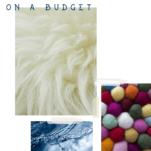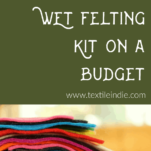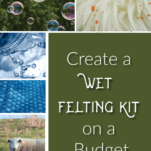This post contains affiliate links. I could be an affiliate for many different products, but I chose these specifically because they are the products and brands I like and recommend. By using my links, you help support this website.
There are five basic materials you need to create a wet felting kit on a budget. These include soap, wool fiber, water, a piece of textured material like bubble wrap or window screen, and a towel. Using these tools and materials you can make flat felt and 3d objects in a variety of shapes and sizes.
Wet felting takes a few tools and materials. It is easy to get in to and you can create some fun pieces without spending a ton of money. Most of the supplies, like soap and a towel you probably already have around your home.

Supplies you will need for wet felting
- Soap
- Wool fiber
- Access to hot water and cold water
- Bubble wrap, window screening, sturdy tulle or bamboo mat
- Towel
| Wet felting basics: | Where to get it? |
| Felting fibers | The Woolery Felting Fibers |
| Olive oil soap | The Woolery Olive Oil Soap |
| Bubble wrap | Bubble wrap (or recycle) |
| Bamboo mat | |
| Wet Felting Bulb Sprayer | Wet Felting Bulb Sprayer |

What soap to use for wet felting?
When starting out any liquid dish soap, laundry detergent or even shampoo that you have on hand will work.
I like to use biodegradable soap, especially if I am working outside on my lawn. A soap that is gentle and unscented is also good. When wet felting I try to find something that is as chemical-free as possible. I’ll be working in it with my hands a lot and washing it away in the sink or in my yard so I like to use something that is environmentally conscious and gentle on the skin.
Update 11/20: I have learned that Olive Oil bar soap is very nice to work with. Thrive Market carries a nice three bar set.

What types of fiber to wet felt
To start out I suggest using sheep wool or alpaca fiber. These fibers are easier to felt and respond to the felting process more readily.
When purchasing fiber don’t choose a superwash fiber as this has been treated so that it will NOT felt. This is great when spinning yarn and knitting, but not helpful when you are intentionally trying to make felt.

Where to buy wool fiber
My favorite place to buy fiber online is Paradise Fibers. They have a great selection of sheep wools and other fiber types. You can purchase undyed wool and dye it yourself using my How to Make Natural Dyes from Plants post. Or you can purchases dyed material in the colors of your choosing.

Water and wet felting
Wet felting involves a lot of water. Along with friction, going from hot to cold water “shocks” the fibers into shrinking together and becoming denser and denser assisting in the overall felting process.
Use water that is as hot as you can comfortably work with. For the cold water you can switch to something that is cold to the touch; it doesn’t have to be ice water.

Using bubble wrap or window screening to wet felt
Felting is a process of using water, soap, and friction to purposefully tangle fibers together to form a fabric. We’ve discussed soap, water, and the fiber aspects of wet felting above. Now for the friction source.
The biggest source of friction will be your hands. Using your hands in circular motions over the surface of flat felt, or rubbing in circles on 3d objects causes a lot of friction that creates felting.
Other sources of creating friction are bubble wrap, window screening, tulle fabric, and anything else that has a gentle texture that you can rub over the fibers.

The size or amount of these materials you will need depends on the size of the project you are doing. The larger the piece of felt the larger the piece of material needed. If you are creating a piece of flat wet felt then you will need a piece of friction material that is bigger than the piece you are making. If you are making a 3d object having a large piece to start with and smaller pieces to rub with works well.

Other tools you can use for wet felting
Other tools that are not necessary but could be added to your kit later:
- Spray bottle
- Wooden dowel
- Other textured surfaces or objects to use to create friction on the felt.
Share with us!
If you wet felt something using our kit suggestions above share a photo with me on Instagram @textileindie. I would love to see what you create!
Join my email list for regular updates on latest posts, new resources and to be notified when I release new youtube video, courses, printables, and more.




